Interviews & Reports
Spinning Tops, A Lifelong Love (1)Author: Hai@Luisiana
This article is written by a spinning top enthusiast in Louisiana. JTCO deeply appreciates his kind contribution.
Have you ever witnessed something so simple, yet profound that it continues to captivate you years later? For me, it’s a simple children’s toy; a spinning top. The specific example that caught me was wooden with a metal tip and is thrown with a string. I have been enamored with spinning tops since I was a child, and I have been actively collecting spinning tops for the last 13 years. The greatest version of a spinning top I have found is the Japanese form. I have come to find that Japanese spinning tops have a heightened level of beauty, craftsmanship, and artistry to them.
Japanese tops in my collection
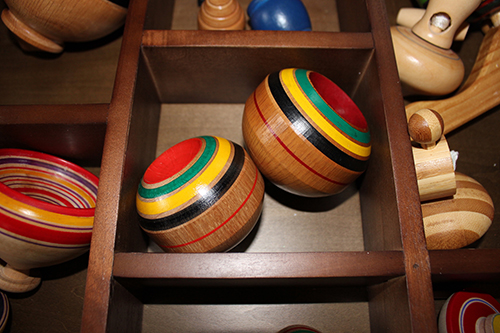
My 13 year collecting journey is what brings me here to JTCO. In my journey, I have scoured the internet for any resources that would allow me to procure various pieces. Recently on this journey, I came across an amazing and informative article about Sasesbo Top. I contacted JTCO to see if they could help me discover more shops in Japan that are still crafting spinning tops. By the blessing of God, Noriko Osaka responded and has been helping me ever since. She has been an amazing friend in helping me on my journey. She has asked me to write a little piece on my passion of spinning tops, and I gladly obliged.
A little about me… My name is Hai. I’m 31 years of age. I’m a manager of software development for large technology company. I was born and raised in Louisiana, United States. It’s in the southern region of North America.
How it started…
It all started when I was 6 years of age at school. I saw a crowd of older kids circled around an area of the playground all cheering. I approached to see what all the commotion was about. When I arrived, I saw a portion of the kids battling with wooden spinning tops. It involved two rounds. In the first round, all of the kids would spin their tops at the same time. The last top spinning was the winner. The first top to stop was the loser. In round 2, the loser of round one had to spin their top first, while the other kids got an opportunity to smash the metal tip of their tops into the other kids. At that point, I was hooked. I had to have one of my own. Here is what the tops looked like:
American Tops
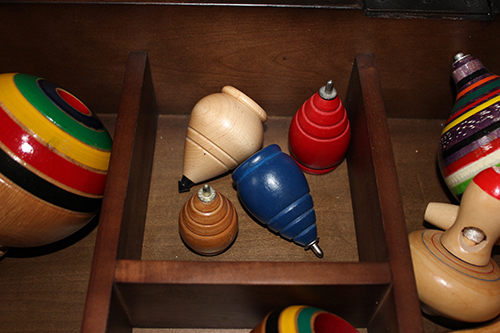
This interest lasted me a couple more years, but it eventually faded. Years would pass, and I would start attending college. In college, I had an epiphany while studying software development and technology. The internet was vast with a wealth of information available. Information could be found on anything. Could I search the internet for the toys of my childhood? At that point, I scoured the internet and found that there were so many cultures on this planet that have spinning tops. It ranged from America to Mexico to Spain to China to Japan to Germany to India. All over the world, kids played with spinning tops of various fashions.
This was amazing. One common children’s toy, but so many forms and interpretations. The basics were all the same: wooden body, metal tip, and thrown with a length of string. I discovered I could purchase many examples on ebay, so I searched constantly.
One day, I discovered an item that was titled “Nagasaki Iron Tip Sasebo Fighting Top”. It was round in shape, with an elaborate array of colors painted on top. It had an interesting tip, almost dangerous. I knew when I saw it, I had to have it. I stayed up until 4AM local time to watch the end of the auction. I won!
At that moment, I continued to check ebay and the internet every few months for more examples of Japanese spinning tops. I discovered that Sasebo tops were not the only form. I found so many, but it was hard to find the information as I do not read Japanese. The more I discovered, the more i yearned to find and collect all of them. They were all so beautiful.
Here is my collection:
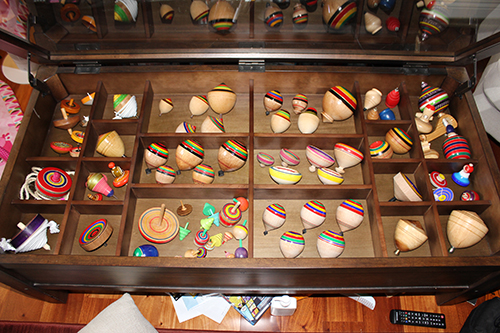
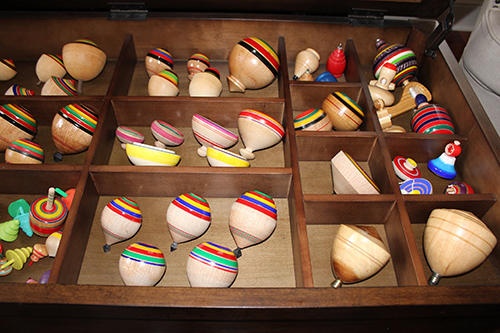
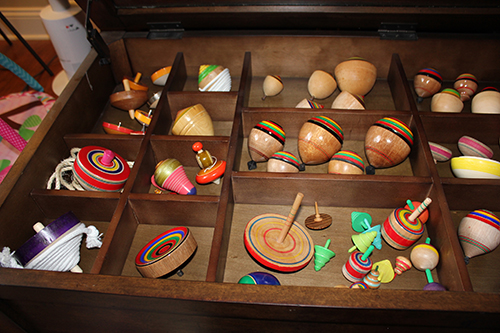
Western VS Japanese Tops
When the Sasebo Top arrived, it came with an ornate display stand. I unpackaged it and attempted my first throw. The way it spun in place, I knew it was engineered perfectly balanced. The form was so beautiful and symmetrical. To me, what I had in my hands was more art than toy. It made me feel a special way. My heart was pounding. This top had spoken to my soul and provided a level of calm that was unusual. The experience, as mundane as it may seem, was so profound.
My experience prior to this was that the implementation of tops was merely more of a form of toy. The beauty and aesthetic weren’t really taken under consideration. This experience was mainly with the American style of tops.
I found that the Japanese tops had a perfect balance of beauty and function. The Sasebo top spun perfectly balanced in place for a great amount of time. It also was beautifully crafted and painted. It’s this combination of beauty and perfect balance/function that enamors me. I think it speaks to a quality I’ve found in Japanese culture. There’s a sense of pride in everything the Japanese do. Whatever the task is, the Japanese perform it to a level of quality they can be proud of.
-- To be continued to Spinning Tops, A Lifelong Love (2)




